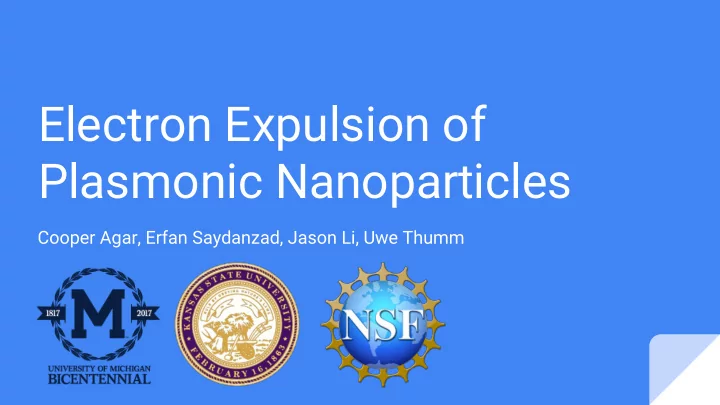

Electron Expulsion of Plasmonic Nanoparticles Cooper Agar, Erfan Saydanzad, Jason Li, Uwe Thumm
Background ● Model gold nanospheroids ○ Hit them with an IR pulse inducing plasmonic field ■ Enhances field ■ This is calculable ○ Hit them with an XUV pulse to excite electron ○ Known as streaking - vary τ
Calculate Electron Trajectory 1. Excitation a. Initial energy from XUV 2. Transport to the surface a. Analytic b. Could change direction through collisions 3. Escape from the surface a. Overcome potential barrier V 0 = ε F + W 4. Propagation to detector a. In E-field, this is numeric
Sampling Trajectories ● Use Monte Carlo ○ Normalized to maximum yield ○ ~4,400 trajectories per time delay ● Have an initial probability density function (PDF) ρ( r 0 , v 0 ) = ρ pos ( r 0 )ρ vel ( v 0 ) ○
Surface and Transport Effects ● Surface Effect ○ Initial radial velocity determines escape ● Transport Effect ○ Greater interior distance means more collisions They combine to make escape at the poles much more likely.
Intensity Enhancement in Space IR pulse not to scale
Intensity Enhancement in Space IR pulse not to scale
Intensity Enhancement in Space IR pulse not to scale
Streaked Spectra with E inc at π/3 rad.
Streaked Spectra with E inc at π/3 rad.
Streaked Spectra with E inc at π/3 rad.
Streaked Spectra with E inc at π/3 rad.
Streaked Spectra with a z = 15 nm
Streaked Spectra with a z = 15 nm
Intensity Enhancement in Space
Conclusions ● Streaked spectra of nanoparticles are shape dependent ● Streaked spectra depend on the incident angle of the IR pulse In future: ● ○ Investigate variance ○ Vary incident angle of XUV pulse ○ Rotate both pulses
Recommend
More recommend